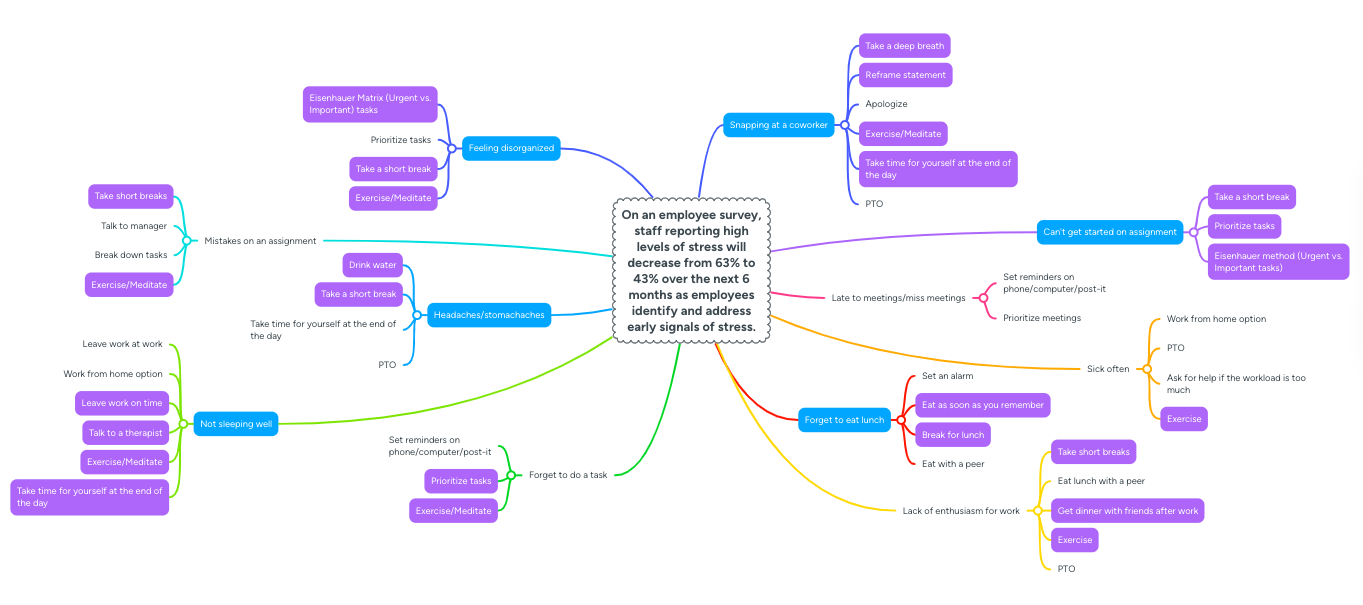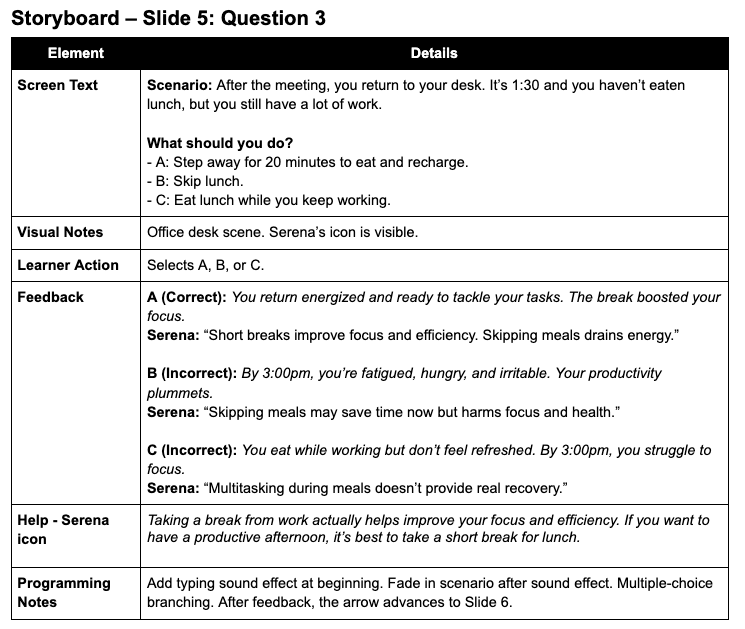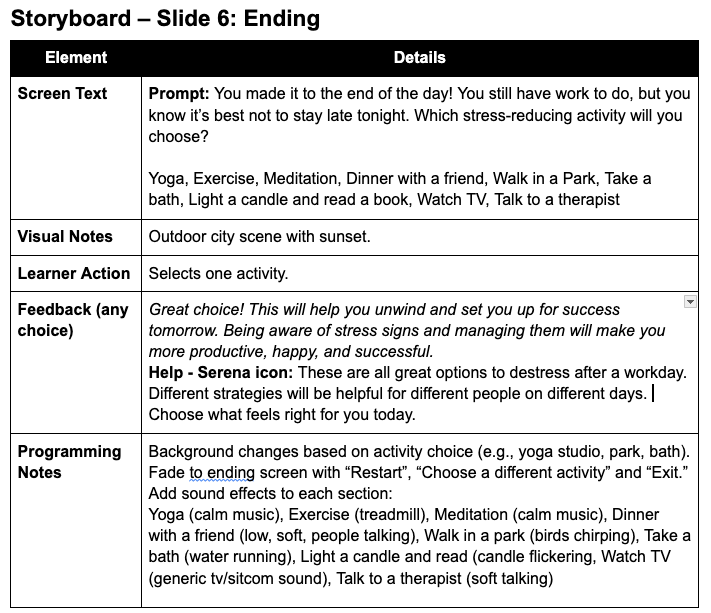Everyday Resilience:
Handling Stress at Work
In this concept project, I designed a scenario-based learning experience to help employees at a fictional company, Brightwave Solutions, manage common workplace signs of stress.
Audience: All employees at Brightwave Solutions, a mid-size technology and consulting firm
Responsibilities: Action mapping, storyboarding, visual mockups, full eLearning development
Tools Used: Storyline 360, Mindmeister, Freepik, Figma, Pixabay, ChatGPT
The Problem
Brightwave Solutions is a mid-size technology and consulting firm in Chicago. After rapid growth, employees have been juggling tight deadlines, an increase in workload, and demanding clients. In a recent employee survey, 63% reported high levels of stress.
Research shows that stress and productivity move in opposite directions — the more stress employees feel, the less productive they are. (Bui, Zackula, Dugan, & Ablah, 2021).
The Solution
To address employees’ high stress levels, I designed a scenario-based eLearning experience that helps them recognize signs of stress and practice strategies for managing it. Scenarios were the right fit because they mirror real work situations, letting employees make choices in a safe environment and see both positive and negative outcomes. This approach makes the learning personal and directly transferable to their day-to-day roles.
Of course, this course is only one part of the solution. For lasting impact, Brightwave Solutions would also need to foster a workplace culture that supports healthy habits—encouraging breaks, promoting balance, and making mental health resources accessible.
To make this elearning experience valuable to Brightwave Solutions employees, I applied the ADDIE method of development. During the analysis phase I worked with an SME, a therapist, to learn more about stress in the workplace and to brainstorm possible solutions.
To set the right tone in the design phase, I emphasized a calm color scheme and background images.
I collaborated with other instructional designers and my SME throughout the development process to ensure that I was creating an effective and engaging experience.
My Process
Action Map
First, I identified the core learning goal: help employees decrease stress by recognizing early signs and taking proactive steps.
I then worked with an SME (a licensed therapist) to create an action map. Using MindMeister, we mapped signs of stress and actionable strategies. We also noted cultural factors Brightwave could improve (encouraging PTO, flexible schedules, calming spaces, access to resources). Many of these solutions drew from industrial-organizational psychology, which helped us tie individual stress management skills to broader workplace practices.
This action map set the foundation for the course.
Text-Based Storyboard
For the design phase, I built a “day in the life” scenario where employees face everyday workplace stressors. At each decision point, learners choose how to respond and see the effects of their choice. This structure encourages learners to move past just knowing about stress to actually practicing how to manage it — connecting directly to Bloom’s higher-level skills.
To streamline the process, I used ChatGPT to generate a first draft of the storyboard. This freed me up to focus on refining flow, instructions, and learner feedback — ensuring every interaction felt natural and purposeful. It also demonstrates how I use AI tools strategically to save time without sacrificing quality.
I also created Serena, a wellness counselor who guides learners through the experience. She offers encouragement and tips along the way, which ties back to Gagné’s 9 Events — things like gaining attention, providing support, and reinforcing the learning at just the right moments.
To enhance retention, I decided to end the experience with a variety of stress-reducing after-work activities (exercise, get together with friends, take some quiet time), as these strategies were identified in several areas on the action map.
The storyboard helped me visualize the course flow and build a mentor character who guided learners in a consistent, supportive way.
Visual Mockups
I wanted the visuals to feel calm and welcoming, so I started by building a style guide in Figma. This gave me a central place to test ideas and share them easily with others. For fonts and colors, I focused on choices that balanced mood and function — they set the right tone while also keeping everything clean and easy to read.
Having these elements chosen before the development stage helped my stay consistent throughout the experience.
I had a specific vision for the background images at Brightwave Solutions as well as the after-work activity images so I decided to use FreePik’s AI Image Generator for this project. For the office images, I created modern and simple images incorporating the colors I chose on my style guide. I incorporated calm sunsets, comfortable settings, and relaxing sound effects for the after-work activity options.
Creating background images with AI was such a fun challenge for me. I was so pleased with how I was able to bring my vision to life this way.
Full Development
Using Storyline 360, I brought the storyboard and visual mockups to life with branching, sound, and layers. Feedback from peers and a therapist SME helped shape the final product —for example, I added calming background music to some scenes to reduce cognitive load and deepen immersion.
The end result is an interactive, story-drive course that helps learners recognize stress early, try strategies in a safe environment, and carry those strategies into their own workday.
Takeaways
From start to finish, I really enjoyed creating this scenario-based eLearning experience. Experimenting with AI-generated images was a highlight—they helped bring my vision to life and set a calm, consistent tone for the course. Working with my SME, a licensed therapist, also gave me valuable perspective. She helped me connect my design choices to industrial-organizational (IO) psychology, showing how teaching employees to recognize and manage stress supports both well-being and performance. That helped me see this project not just as a training module, but as part of a bigger strategy for healthier workplaces.










